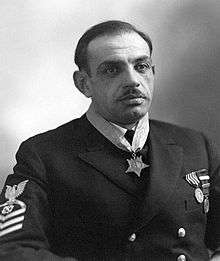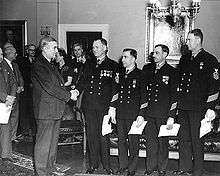Orson Leon Crandall
| Orson Leon Crandall | |
|---|---|
 Chief Boatswain's Mate Orson L. Crandall, January 19, 1940 | |
| Born |
February 2, 1903 St. Joseph, Missouri |
| Died | May 10, 1960 (aged 57) |
| Place of burial | Arlington National Cemetery |
| Allegiance | United States of America |
| Service/branch | United States Navy |
| Years of service | 1922–1952 |
| Rank | Lieutenant |
| Unit | USS Falcon (ASR-2) |
| Awards | Medal of Honor |
Orson Leon Crandall (February 2, 1903 – May 10, 1960) was a United States Navy diver and a recipient of America's highest military decoration - the Medal of Honor.
Biography
Orson Crandall was born on February 2, 1903 in St. Joseph, Missouri. He enlisted in the Navy from Connecticut in June 1922, serving in several ships over the next decade. Trained as a diver in 1932-33 and designated a Master Diver in March 1939, he was serving in USS Falcon (ASR-2) when she supported the rescue and salvage effort on the sunken submarine USS Sailfish from May to September 1939. Chief Boatswain's Mate Crandall was awarded the Medal of Honor for his actions as Master Diver during that operation.
During World War II, Crandall became a commissioned officer and served in a variety of salvage and diving-related positions. He transferred to the Fleet Reserve in June 1946 and retired in December 1952.
Lieutenant Orson L. Crandall died on May 10, 1960 and was buried in Arlington National Cemetery, Arlington County, Virginia. His grave can be found in section 48 Lot 2004.[1]
Namesake
USS Crandall (YHLC-2), 1967–1993, was named in honor of Lieutenant Crandall.
Medal of Honor citation

Orson Crandall's official Medal of Honor citation is as follows:
For extraordinary heroism in the line of his profession as a master diver throughout the rescue and salvage operations following the sinking of the U.S.S. Squalus on 23 May 1939. His leadership and devotion to duty in directing diving operations and in making important and difficult dives under the most hazardous conditions characterize conduct far above and beyond the ordinary call of duty.
See also
Notes
- ↑ "Crandall, Orson", Findagrave.
References
 This article incorporates public domain material from websites or documents of the Naval History & Heritage Command.
This article incorporates public domain material from websites or documents of the Naval History & Heritage Command.
- "Orson Leon Crandall". Claim to Fame: Medal of Honor recipients. Find a Grave. Retrieved 2007-10-23.
- Naval Historical Center (2000-07-07). "US People - Crandall, Orson L.". Online Library. Retrieved 2006-08-07.